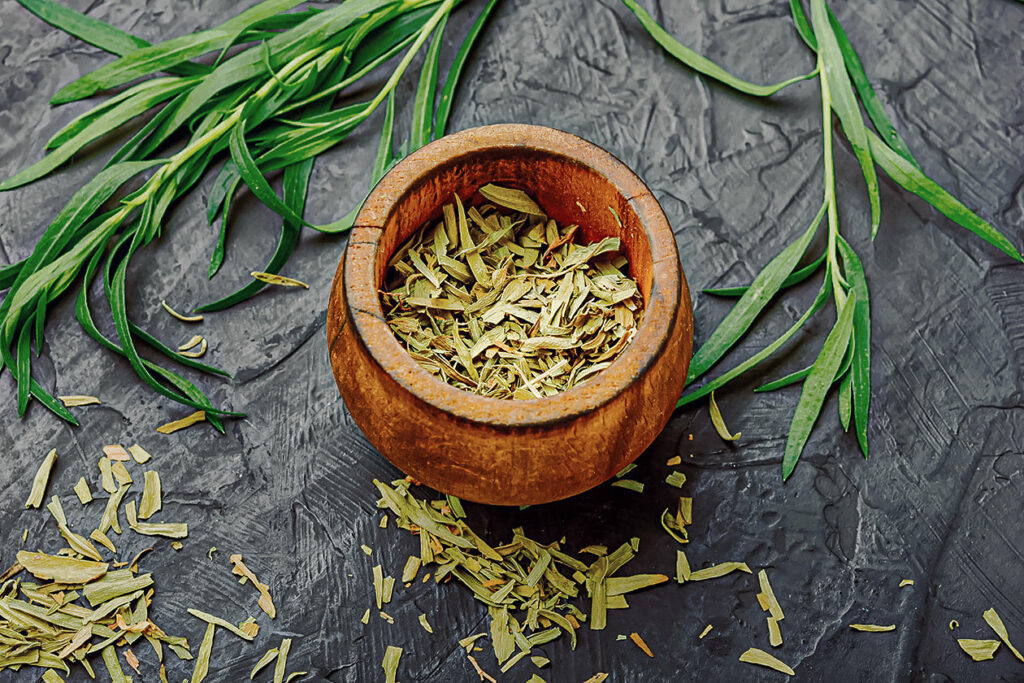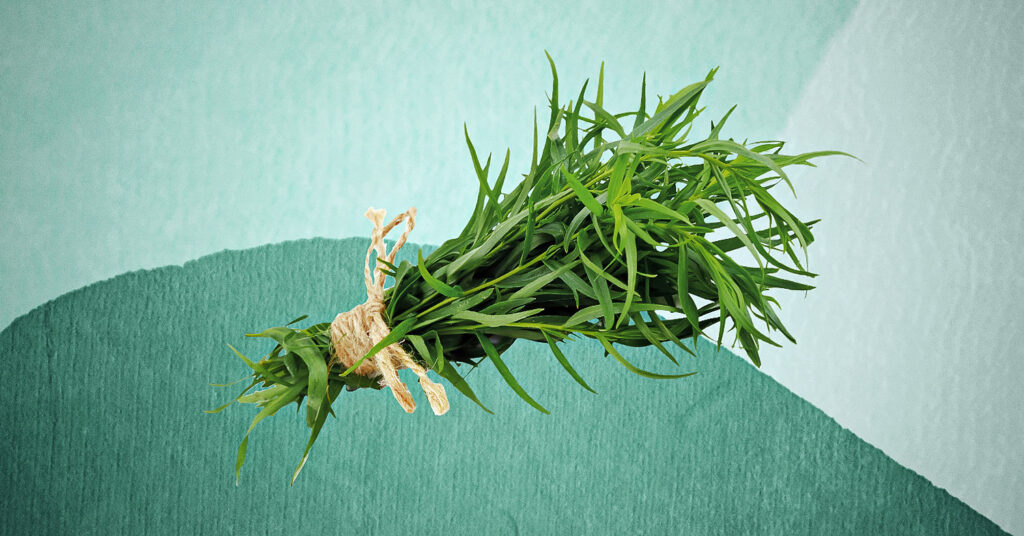If the first thing you think when you see a recipe with tarragon is “What is tarragon,” you’re not alone. This fresh herb with slender, glossy leaves isn’t often used in everyday American cooking, with basil, parsley, rosemary, and thyme typically getting the lion’s share of attention in the kitchen.
But give this unsung culinary hero a chance (or two, or five—it’s incredibly versatile!). Once you fall in love with tarragon’s fresh, herbal, slightly sweet anise, fennel, and pepper flavors, nothing else will suffice in dressing your masterful lemon cashew pasta and mustard-glazed Brussels sprouts. The simple, delightful truth about this elusive herb is that it can really kick up your flavor quotient for complementary base ingredients like tofu and seitan, creating an aromatic, savory showstopper for dinner parties, picnics, and potlucks.
Though this aromatic perennial herb is a French chef’s familiar friend, cooks in the U.S. may fear its potency. Tarragon, like fellow flavor bruiser cilantro, packs a big culinary punch. While cilantro has certainly found its place in our collective palate—unless you’re one of the unlucky few whose tastebuds it inexplicably assaults—tarragon’s pronounced licorice flavor can occasionally be off-putting to the American palate. That said, if licorice was your childhood jam and you were the sole beneficiary of everyone leaving behind the licorice jelly beans, whips, and Good ‘n Plentys, tarragon is almost certain to be your favorite new ingredient.
You’re more likely to find tarragon in French and other European dishes like béarnaise sauce, cream sauce for asparagus, egg dishes, and vinaigrettes for salads and vegetables. It’s also a key ingredient in the French fines herbes blend, which also contains chervil, parsley, and chives. Looking for a way to spruce up your tofu scramble or Just Egg omelet? Chop up your own fines herbes, or sprinkle in a quarter to half a teaspoon of a dried blend.
Tarragon is a popular flavor of mustard in France, frequently finding its way into the dressings that elevate simple, elegant French salads to world-renown—we’re looking at you, Niçoise. Anyone looking to upgrade their French cooking repertoire would be well-served to make friends with fresh tarragon, but novice chefs can easily make use of this delectable herb in everyday dishes.
How to cook with tarragon: 6 recipe ideas

Tarragon’s flavor is most concentrated in its leaves, so you’ll generally want to pull those off, discard the stem, and chop coarsely or finely before using. You can also add whole tarragon leaves to your dish if you like that visual effect—tarragon lovers will be delighted to see it—or toss whole sprigs into a braise or stock and fish them out before serving. Like its delicate brethren basil and cilantro, tarragon bruises easily and oxidizes rapidly, so handle it with care and use it right after chopping (lest it turn brown and mushy).
Though tarragon is famous for flavoring sauces and stocks, this herb is useful for much more than cooking—especially once you’ve been hooked by its savory, herby allure.
Explore complementary flavors
Looking for a place to start? Tarragon’s astringent, herbal flavor pairs well with lemon, orange, mint, black and white pepper, nuts, sherry, garlic, butter, and spring vegetables like fava beans and artichokes. Chop leaves roughly or finely and add them to a dish at any stage of cooking. Keep in mind that the longer tarragon cooks, the mellower the flavor will be. If you’re looking for a sharper, fresher flavor, add it towards the end of cooking, or to garnish. If you want a subtler accent, add tarragon to a dish during the simmering or roasting stage.
Veganize a classic dish
Tarragon is often paired with chicken in cream sauce for a traditional French dish called “poulet à l’estragon.” Its palate-pleasing flavors translate beautifully to a vegan preparation. Substitute vegan butter and soft cashew cheese for the dairy in the sauce, then stir in chopped tarragon and pour over plant-based chicken or braised mushrooms for a hearty, delicious dinner that highlights the herb’s bright, springy flavor.

Use it as a garnish
Why should parsley, basil, and cilantro get all the spotlight when it comes to the final flourish? Finely chopped tarragon makes a fantastic garnish on its own, whether or not you’ve used the herb in the dish. This can be especially useful when you’ve just finished cooking something delicious, only to sorely realize you wish you’d added tarragon.
Use it as a marinade
Tarragon’s potency makes it a welcome addition to marinades, which are made to pack in as much flavor before cooking as humanly possible. Add chopped tarragon leaves or whole springs to simple citrus and herb marinades. I love splashing a little white wine in a tarragon marinade for extra brightness—white wine and tarragon are longtime friends.
Make tarragon ice cream
This wonderfully versatile herb also pairs well with fresh summer fruit, which coincides nicely with its natural warm weather growing season. Combine peaches or nectarines, apricots, and plums with tarragon to create fruit salads, baked desserts, and frozen treats like ice cream and sorbet.

Mix a tarragon-tini
Fresh tarragon is absolutely delicious in drinks and cocktails. It’s an easy way to add complexity to non-alcoholic drinks like lemonade and iced tea, and to spice up gin and tonics, negronis, martinis, and gimlets. Simmer tarragon in equal parts sugar and water for five minutes to create a zippy simple syrup you can shake up in cocktails or splash into seltzer. You can also stash tarragon in a bottle of booze (like vodka or gin) and let it infuse for up to a week, depending on how strong you’d like the resulting flavor to be.
Dried tarragon vs. fresh tarragon

Dried tarragon is readily available in the herbs and spices section of supermarkets, and while there’s a stark absence of its fresh counterpart’s signature springy characteristics, dried will suffice in a pinch when you’re faced with the choice of “subtle tarragon flavor” and “no tarragon flavor.” Substitute one-quarter teaspoon of dried tarragon for a teaspoon of fresh tarragon.
How to take care of tarragon
Store tarragon sprigs upright in a glass of water in the refrigerator to keep them well-hydrated for up to a week, removing them as needed.
Growing your own tarragon is a great way to add more variety to your favorite recipes. This plant flourishes without much attention, is disease- and pest-resistant, and can grow up to three feet tall in your garden or window box with nothing more than abundant sunlight and a weekly watering.
Tarragon takes well to air-drying, so at the end of the season (or if you find yourself with a farmers market glut), snip the remaining stalks, tie small bunches, and hang them upside-down in a well-ventilated area. When the leaves are dry to the touch, untie the bundles, carefully transfer the leaves to jars with tight-fitting lids, and store in a cool, dry place for up to a year. You can also preserve tarragon by drying it in a dehydrator or oven at the very lowest heat (no more than 100°F).
Next time you find a fresh bunch of tarragon at the farmers market—or even one of those slim supermarket clamshells containing a few stalwart stems—pick it up and get to know it a little better. This food-friendly fresh herb is a low-lift, low-effort way to pack flavor into a huge range of new and familiar favorites. If you ask us, the answer to “How the f@#! do I cook with tarragon” is a resounding “in a million awesomely delicious ways.”
The perfect starter tarragon recipe
This creamy vegan sauce makes tarragon the star by incorporating it at the end, and is perfect served over pasta, mushrooms, or your favorite plant-based protein.
Our “How the F@#! Do I Cook With” series explores the mouthwatering, practical, awe-inspiring, and infuriating qualities of kitchen ingredients. What ingredient has you stumped? Write to us at editorial@livekindly.com with the subject line “How Do I Cook With” and then name your ingredient!


